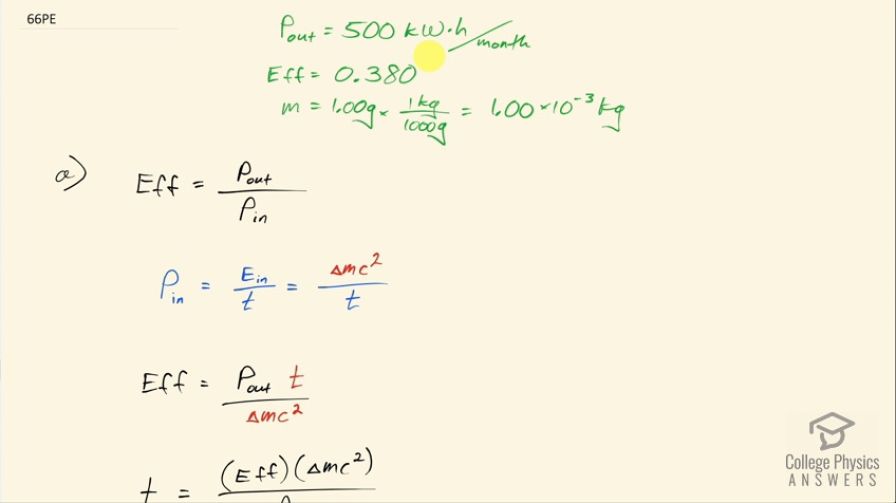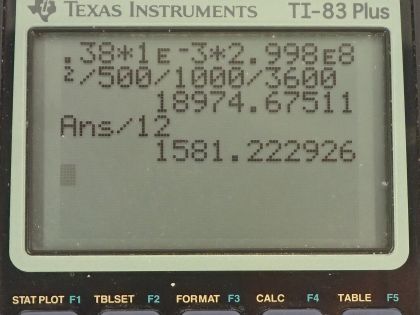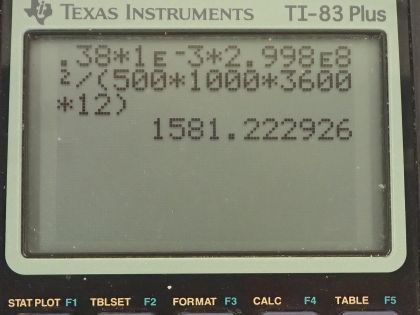Question
Suppose you use an average of of electric
energy per month in your home. (a) How long would 1.00 g of mass converted to electric energy with an efficiency of 38.0% last you? (b) How many homes could be supplied at the per month rate for one year by the energy from the described mass conversion?
Final Answer
- 1580 years
- 1580 homes
Solution video
OpenStax College Physics, Chapter 28, Problem 66 (Problems & Exercises)

vote with a rating of
votes with an average rating of
.
Calculator Screenshots
Video Transcript
This is College Physics Answers with Shaun Dychko. Imagine that your house consumes energy at a rate of 500 kilowatt-hours every month so this is the power consumption of the house and there's an efficiency between energy production using conversion of mass into energy of 0.380 or 38 percent and I described this 500 kilowatt-hours per month as P out with a subscript 'out' on it because our formula for efficiency is the power output, which is delivered to where it belongs like it's used in the intended way divided by the power input—the rate at which energy is created. Okay! So the power input is the energy that's created through the conversion of mass into energy per time and so we can substitute mc squared over t in place of P in and since we are dividing by this fraction, I am going to instead multiply by its reciprocal so I am going to flip this fraction over and multiply by it here. So the efficiency then is the power output times time over mc squared and we can solve this for t by multiplying by Δmc squared over P out on both sides and then we'll find out how long we can power the house for. So the time then is the efficiency times the energy created by converting 1.00 gram of mass into energy divided by the rate at which energy is consumed by the house. So we have 0.380 times 1.00 times 10 to the minus 3 kilograms times the speed of light squared divided by 500 kilowatt-hours per month and this has to be converted into joules per month and then our time will have units of months since we have per month in the denominator. So we multiply by 1000 watts per kilowatt and then times by 3600 seconds per hour and now we have watt-seconds per month and these are all mks units— meters, kilograms and seconds— the watts just has meters, kilograms, seconds in it and we are left with reciprocal months in the denominator and so that makes this... months is going to be our unit that we have in the end. So that's 1.89747 times 10 to the 4 months times by 1 year for every 12 months and that's 1580 years, which is quite impressive so only 1.00 gram of material can power a house for millennia. Part (b) says how many homes could be supplied with energy if it uses at the same rate of 500 kilowatt-hours per month and with the same amount of mass converted? So the efficiency is the energy input over energy output and the energy input now is the number of houses multiplied by the power per house multiplied by time. So power per house is the number that we are given... we are given 500 kilowatt-hours per month per house so this is dividing by number of houses in terms of its units. So we can solve this for N by multiplying both sides by E out and divide both sides by power per house times time and we get the number of houses then is the efficiency times the rate at which energy... or not the rate I should say but the amount of energy produced divided by the rate at which it's used per house times time. So that's 0.380 times 1.00 times 10 to the minus 3 kilograms times speed of light squared divided by 500 kilowatt-hours per month per house times 1000 watts per kilowatt times 3600 seconds per hour and now we have watt-seconds in the bottom and we are going to convert this into years by multiplying by 12 months per year and then we have a one year period— we are told in part (b)— how many houses can be provided with energy for a period of one year? So that's where this 1 year comes from— that's t— and the years cancel and we're left with 1580 homes.

